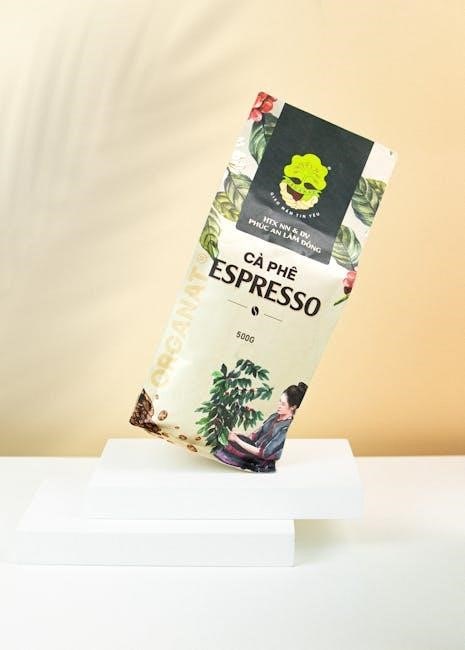Vietnamese coffee is a traditional beverage made from robust beans, often served with sweet condensed milk, introducing a unique taste experience to coffee lovers, using a small metal filter called phin, every morning, daily, always, online.
History of Vietnamese Coffee
Vietnamese coffee has a rich and fascinating history that dates back to the French colonization period, when coffee was first introduced to Vietnam in the mid-19th century, and the country quickly became a major coffee producer, with the first coffee plants being cultivated in the central highlands region. The French brought their coffee culture with them, including their brewing methods and coffee drinks, such as café au lait and café noir, which were adapted by the Vietnamese people to create their own unique coffee culture. Over time, Vietnamese coffee evolved into a distinct and flavorful beverage that is now enjoyed not only in Vietnam but also around the world, with its own unique brewing methods, such as the traditional phin filter, and flavor profiles, which are shaped by the country’s climate, soil, and coffee bean varieties. The history of Vietnamese coffee is a story of cultural exchange and adaptation, and it continues to play an important role in shaping the country’s coffee culture today, with many coffee shops and cafes serving traditional Vietnamese coffee drinks, such as cà phê sữa đá, which is made with strong coffee, sweetened condensed milk, and ice.

Vietnamese Coffee Culture
Vietnamese people gather in cozy cafes, socializing and enjoying coffee, creating a unique and vibrant cultural scene, with rich traditions, every day, always, online, in Vietnam, with friends, and family, together, daily.
Traditional Phin Filter Brewing Method
The traditional phin filter brewing method is a distinctive aspect of Vietnamese coffee culture, allowing for a rich and full-bodied coffee experience. This method involves using a small metal filter, known as a phin, which sits atop a cup, slowly dripping coffee into it. The phin is typically made of metal and has small holes in it, which allows the coffee to drip through, creating a concentrated coffee. The coffee is usually served in a small cup, and the brewing process can take several minutes, depending on the coarseness of the coffee grounds and the desired strength of the coffee. The traditional phin filter brewing method is a labor of love, requiring patience and attention to detail, but resulting in a truly unique and delicious coffee experience. The phin filter is an essential part of Vietnamese coffee culture, and its use is deeply ingrained in the country’s coffee traditions.

Comparison with Other Coffee Cultures
Vietnamese coffee is compared to other cultures, like Cuban, using different brewing methods and flavors, every day, online, with unique taste experiences, and various coffee beans, sourced globally, always.
Differences between Vietnamese and Cuban Coffee
The differences between Vietnamese and Cuban coffee are notable, with Vietnamese coffee being known for its strong and rich flavor, often served with sweet condensed milk, while Cuban coffee is renowned for its dark roast and espresso-style brewing method, using a stovetop espresso maker.
One of the main differences is the type of coffee beans used, with Vietnamese coffee typically made from Robusta beans, and Cuban coffee made from Arabica beans.
The brewing methods also vary, with Vietnamese coffee using a small metal filter called a phin, and Cuban coffee using a stovetop espresso maker, resulting in distinct flavor profiles and textures, making each coffee culture unique and worth exploring, with a rich history and cultural significance, and a variety of flavors and brewing methods to discover, every day, online, with various coffee shops and cafes, serving traditional coffee drinks, and introducing new flavors and blends, to coffee lovers, always, and providing a unique taste experience, and a glimpse into the local culture, and traditions, of Vietnam and Cuba, and their coffee heritage.

Vietnamese Coffee Brewing Techniques
Techniques involve slow dripping, and rich flavors, using various methods and equipment, to create perfect coffee, every time, with a unique taste experience, and aroma, online, daily, always, with coffee.
Using Condensed Milk in Vietnamese Coffee
Vietnamese coffee is often served with sweet condensed milk, which adds a rich and creamy texture to the beverage. The condensed milk is made by heating milk and sugar together, creating a thick and sweet syrup. This syrup is then poured into the coffee, creating a layered effect with the dark coffee at the bottom and the creamy milk on top. The combination of the strong coffee and sweet condensed milk is a unique and delicious taste experience. The use of condensed milk in Vietnamese coffee is a result of the country’s history and cultural influences. The French introduced coffee to Vietnam, but the Vietnamese adapted it to their own tastes by adding sweetened condensed milk. Today, the use of condensed milk in Vietnamese coffee is an integral part of the country’s coffee culture, and it is enjoyed by people all over the world. The creamy texture and sweet flavor of the condensed milk balance out the bitterness of the coffee, creating a smooth and refreshing drink.

Vietnamese Coffee Brands and Manufacturers
Partnerships with Vietnamese Coffee Farms
Many Vietnamese coffee brands have formed partnerships with local coffee farms to source high-quality beans and support the local economy. These partnerships allow the brands to have greater control over the quality and consistency of their coffee, as well as provide economic benefits to the farmers. The farms are typically small, family-owned operations that have been growing coffee for generations. By partnering with these farms, the brands can help to preserve traditional farming practices and support the local community. The partnerships also enable the brands to learn more about the farming practices and conditions, which can help to improve the quality of the coffee. This close relationship between the brands and the farms is a key factor in the production of high-quality Vietnamese coffee. The partnerships are often based on mutual respect and trust, and are designed to be long-term and sustainable. This approach has helped to establish Vietnamese coffee as a major player in the global coffee market.